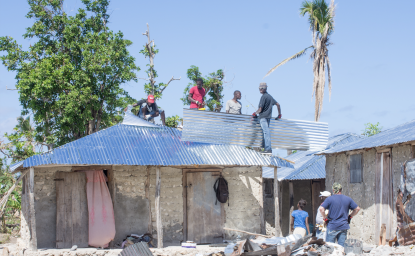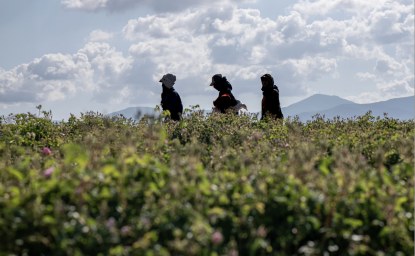In November 2004, just prior to World AIDS Day, the Woodrow Wilson Center and UNAIDS, the joint United Nations Programme on HIV/AIDS, held two high-level briefings as part of a three-part series to expand awareness of the global AIDS agenda outside of the health community, particularly within foreign policy and development circles.
World AIDS Day became an annual event in 1988 when some 5 million people were living with the disease. Since then, AIDS has killed more than 20 million people around the world and, this year, 40 million people are living with HIV/AIDS. In sub-Saharan Africa alone, more than 25 million people are living with HIV/AIDS. In the Caribbean, the region second-hardest hit by the disease, at least 1 in 50 adults across five nations already are infected.
A November 10 seminar featuring Dr. Kathleen Cravero, deputy executive director of UNAIDS, and Ambassador George Moose, former assistant secretary of state for African affairs, shed light on the disproportionate impact HIV/AIDS has had on women in developed and developing countries. The second briefing on November 30— featuring UNAIDS Executive Director Dr. Peter Piot and U.S. Global AIDS Coordinator Ambassador Randall Tobias—explored the aggressive U.S. emergency plan to combat AIDS and the dangerously fast spread of HIV/AIDS in East Europe and East Asia. A third upcoming seminar will delve into the effects of AIDS on security.
Every day around the world, 8,000 people die from AIDS, many of them young people in their productive years, many of them mothers and caretakers. It is a humanitarian crisis that poses serious social, economic, and security threats—one that requires a sustained, collective effort to overcome.
The Emerging Pandemic: East Europe, Asia
UNAIDS reported at the end of 2004 that nearly a half-million people died from AIDS in South and Southeast Asia and more than 7 million people are living with HIV/AIDS, while in East Asia more than 1 million people are HIV-positive. In addition, nearly 1 million Russians are living with HIV/AIDS, about triple the official statistics, according to Wilson Center Senior Scholar Murray Feshbach and Research Associate Cristina Galvin in a recently released report underwritten by the U.S. Agency for International Development.
"The situation we face in China, India, and Russia bears alarming similarities to the situation we faced 20 years ago in Africa," said Dr. Piot in his November 30 address. Piot said these countries are nearing "a tipping point," much like Africa had experienced. In South Africa, he explained, prevalence rates rose from .5 to 1 percent in five years but then in seven years, the rate leapt from 1 to 20 percent.
Piot said, "I am calling for intensified attention on these next wave countries-not at the expense of Africa, but also on behalf of Africa." If the epidemic spreads, he said, global resources for Africa could decrease or disappear. "If we don't prevent this breakout, and full-blown epidemics take hold in these large, populous states, there will be dire consequences not only for these countries, but for each of our own."
Well over half the world's population resides in Asian-Pacific countries, where HIV/AIDS-related income losses totaled more than $7 billion in 2001 alone. India and China, two of the world's most populous countries, have rapidly growing economies which would be devastated by the stunted growth that AIDS has caused elsewhere as would their global trading partners. AIDS threatens a nation's security and stability, and national defense can be compromised by the growing rates of AIDS in military ranks.
In Russia, incidents of HIV among potential military conscripts are estimated to be 25 times the level of five years earlier, according to the Feshbach/Galvin report. The report also noted that while HIV is on the rise, testing has dropped dramatically, in a society that stigmatizes those with the virus. In Asia, increasing populations help offset the AIDS mortality levels, but Russia has a declining population. Furthermore, the report noted, AIDS disproportionately impacts Russia's young people; more than 80 percent of HIV-positive Russians are under 30 years old.
"We can pay now for prevention," said Piot, "we can wait a bit longer and pay for treatment; or we can wait even longer and pay the price of losing tens of hundreds of millions of productive citizens. Early investment is everything...the price rises every minute we wait."
Women and AIDS
World AIDS Day, commemorated on December 1, focused special attention this year on the growing AIDS epidemic among women and girls. In sub-Saharan Africa, 60 percent of all HIV-positive people and 75 percent of infected young people, 15 to 24 years old, are female. Some of the steepest increases are occurring in East Asia, East Europe, and Central Asia. In Russia, the Russian Federal AIDS Center reported in 2003 that 38 percent of people living with HIV were women, compared with 24 percent in 2001. In Brazil, new AIDS cases among women increased by 75 percent in the late 1990s, compared to just 10 percent among men. And, in the United States, AIDS is the leading cause of death among African American women, ages 35-44.
"The disproportionate infection of millions of poor women isn't merely an injustice; it's a socioeconomic disaster," said Dr. Cravero, at the November 10 seminar, "Confronting the Crisis: Women and AIDS." Cravero said AIDS among women is on the rise in these countries because "women lack control over their bodies and their daily lives, and the tools, resources and support needed to change their situation."
Ambassador Moose discussed the debate within the U.S. government. He said while the U.S. government has recognized the magnitude of the HIV/AIDS threat and has made advances developing affordable antiretroviral treatments for developing nations, it has yet to address the challenge of women and AIDS.
"It's one thing to bring policymakers and politicians to an acceptance that HIV/AIDS represents a threat to national and international security interests," he said, "but it's quite another, I would argue, to convince them that the place where that battle will have to be fought and won is in the bedrooms and bordellos of every society around the world."
Piot also discussed the rise of AIDS among women and said that solely insisting on abstinence is unrealistic. "The scientists, the doctors, the activists, the churches, and all of us should come together and agree on a broad philosophy of prevention that takes cultural and religious differences into account, but embraces a common principle-that the highest moral ideal is to save lives."
Piot said developing countries must encourage educational and economic opportunities for women, pass and enforce laws that deter domestic violence, and promote access to the female condom and microbicides that women can use to protect themselves.
Said Cravero, "For women who can't choose when and with whom to have sex, for women whose partners will not use condoms or be faithful, and for women who are too beaten up or beaten down to ask, methods that they control...will make all the difference."
The U.S. Relief Plan
On November 30, Ambassador Randall Tobias presented the President's Emergency Plan for AIDS Relief, which commits $15 billion over a five-year period toward combating the disease in more than 100 countries. The plan, which promotes integrated prevention, treatment, and care, is the largest commitment ever by a single nation toward an international health initiative.
With special emphasis on 15 focus nations in Africa, the Caribbean, and Asia, where half the world's infections occur, this plan aims to treat 2 million HIV-infected people, prevent 7 million new infections, and care for 10 million people, including orphans and vulnerable children.
The emergency plan "strives to bring donors, stakeholders on the ground, and national leadership onto the same page," said Tobias, adding that emphasis will be placed on monitoring and evaluating results. "If this HIV/AIDS challenge is to be met, we in the developed world will have to meet it. If we fail to rise to the occasion, there's really no Plan B." He underscored the importance of such organizations as UNAIDS remaining engaged in the fight. Such groups, he said, "offer other donors a vehicle to sharply increase their commitment, as America has done."




